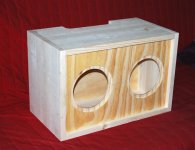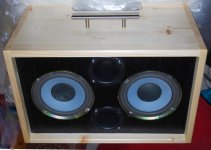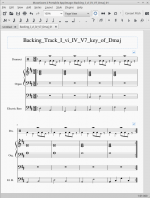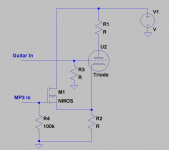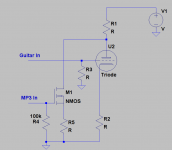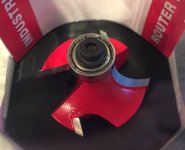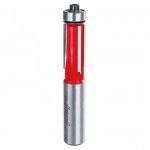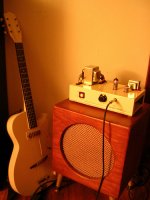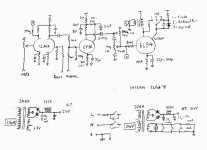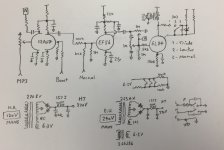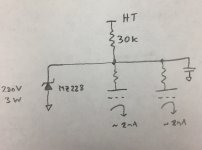As a young guy I was amazed by these spanish guitar players, Carlos Montoya being my idol at a time. I was deeply impressed to see his short and thick fingers on the LP cover - could not image how to play that brilliant with these hands😛
Anyway, there are loads of very different approaches to make this instrument sing. I consider it as one of the most individualistic instruments at all.
Talking about Leonidas - the regular Fender necks are wider than the regular Gibson neck, and they widen more to the bridge side. I got used to finger pick on a Strat, but never on a Les Paul.
Anyway, there are loads of very different approaches to make this instrument sing. I consider it as one of the most individualistic instruments at all.
Talking about Leonidas - the regular Fender necks are wider than the regular Gibson neck, and they widen more to the bridge side. I got used to finger pick on a Strat, but never on a Les Paul.
Last edited:
Member
Joined 2009
Paid Member
Back to the Metronome again - would there be any sense in building one into the amplifier - a simple 'click' could be arranged using the same phase shift oscillator circuit that is used by VOX for their tremelo. I could add that to the amp and have it available at the flick of a switch... thoughts ???
If you use your router and a round-over bit to soften all the edges and corners of your cab, it starts to look much better to the eye.Router and Jigsaw...
<snip>
They're still looking really rough 😀
Here is a possibly useful article on these very handy router bits: Round-over bits basics | WOOD Magazine
And here are a couple pics of a cab I built recently. This was a gift for a friend, so though I am not experienced at carpentry, I tried to make this look attractive. I think the rounded edges add a lot to the appearance.
-Gnobuddy
Attachments
I did something like this in my twenties (actually I built a crude analog drum machine of my own design into a solid-state guitar preamp).Back to the Metronome again - would there be any sense in building one into the amplifier - a simple 'click'
<big snip>
It worked, but the incredibly monotonous sound quickly turned me off it, and it was hard to keep unwanted "clicks" from the fast pulses in the drum machine circuit from being heard through the speaker.
What about building-in a 3mm stereo jack, so you can plug in a 'phone, MP3 player, looper pedal, or computer? I think this will turn out to be more versatile and more useful than a built in metronome. You can use that external device to supply a metronome beat, or a more interesting drum track, or even, when your playing has progressed a bit, a full backing track for you to play along with.
You'll need some sort of extra amplification stage and some sort of simple mixer to get the signal from the 3mm jack up to a reasonable voltage, and to mix it with the guitar signal. I think this would be a good candidate for a couple of LND150 or similar MOSFETs.
By the way, I sometimes use a free, open-source piece of software called Musescore ( Free music composition and notation software | MuseScore ) to create my own backing tracks. I've taught myself a little music notation, enough so I can write a few chords, a bass line, and a basic drum beat into Musescore, and then click the "loop" and "play" buttons to get an endlessly looping backing track. (Monotonous, yes, but less so than a metronome!)
The line-out from the computer sound card is already run into our stereo amp and speakers for watching Netflix, so of course it works equally well for Musescore backing track playback.
I'll attach a screen-shot of a little backing track like this which I put together a couple of days ago. It plays two bars each of D major, B minor, G major, and A seventh using an electronic organ sound, then starts over. There is a simple drum beat to act as a metronome, and a simple bass line to make it sound a little less monotonous. I play this track, then improvise guitar solos over the top.
If you're just starting to learn chords, you could equally well leave out the chord part in Musescore (you can even turn off individual instruments with a mouse click), and play those chords on your guitar along with the drums and bass to keep you on time. Of course you could reduce it to one or two chords, too, until you have a little more learning time under your belt.
By the way, guess what I was just doing for the past hour? Yup, running through guitar exercises...with a metronome!
-Gnobuddy
Attachments
Member
Joined 2009
Paid Member
Thanks for some great input !
I like this idea. The challenge with VOX amps is that they tend to rely on clipping of the output stage for wanted distortion so any 'music' fed through the amp will only be sensible if the amp is not being over-drive. Nevertheless, I expect this will be a limitation I can live with.
What about feeding the MP3 signal into one end of the cathode bypass cap on the EF86 ? The input jack could be a switched type so that it keeps the cathode bypass cap grounded when nothing is plugged in but as soon as an MP3 source is plugged in the cathode bypass cap switches to point to the music source instead of ground ? The MP3 source will mix with the guitar signal in the EF86 - maybe that's a bad idea. Maybe I need to have the mixing done in a resistor. Yeah, scrap that thought.
well, we know by now that this is how I feel about Metronome's in general !It worked, but the incredibly monotonous sound quickly turned me off it,
What about building-in a 3mm stereo jack, so you can plug in a 'phone, MP3 player, looper pedal, or computer? I think this will turn out to be more versatile and more useful than a built in metronome. You can use that external device to supply a metronome beat, or a more interesting drum track, or even, when your playing has progressed a bit, a full backing track for you to play along with.
You'll need some sort of extra amplification stage and some sort of simple mixer to get the signal from the 3mm jack up to a reasonable voltage, and to mix it with the guitar signal. I think this would be a good candidate for a couple of LND150 or similar MOSFETs.
I like this idea. The challenge with VOX amps is that they tend to rely on clipping of the output stage for wanted distortion so any 'music' fed through the amp will only be sensible if the amp is not being over-drive. Nevertheless, I expect this will be a limitation I can live with.
What about feeding the MP3 signal into one end of the cathode bypass cap on the EF86 ? The input jack could be a switched type so that it keeps the cathode bypass cap grounded when nothing is plugged in but as soon as an MP3 source is plugged in the cathode bypass cap switches to point to the music source instead of ground ? The MP3 source will mix with the guitar signal in the EF86 - maybe that's a bad idea. Maybe I need to have the mixing done in a resistor. Yeah, scrap that thought.
Member
Joined 2009
Paid Member
For me, it was Segovia and John Williams for a while. Segovia had big hands and stubby fingers too.As a young guy I was amazed by these spanish guitar players, Carlos Montoya being my idol at a time.
There is a show called "Puss In Boots" on Netflix that has a fantastically fast flamenco nylon-string guitar piece in the introduction to each episode. I don't know who played it, but whoever it was has fantastic playing technique.
It's a sad thing, but the "real" Les Pauls seem to have become much worse guitars than many of the Les Paul copies made by various other manufacturers.I got used to finger pick on a Strat, but never on a Les Paul.
I have an older version of this: Agile AL-3100MCC CSBF Wide - RondoMusic.com
My 3100 CSBM Duncan Wide came with Seymour Duncan pickups and the 1 3/4" nut width, but not the compound-radius fretboard. It also cost a couple hundred bucks more than the version I linked to above, more than, for instance, a Mexican-made Fender Strat.
I found the quality of the Agile much higher than any of the Mexi Strats I tried out.
String spacing is a bit tight (for me) at both nut and bridge for finger-picking, but it can be done with care.
-Gnobuddy
Sounds like an idea worth tinkering with!What about feeding the MP3 signal into one end of the cathode bypass cap on the EF86?
In case you need to feed a relatively high-Z signal in, how about using a MOSFET source-follower to buffer the signal to the cathode resistor (first pic)?
Or how about a "common anode mixer" layout, except with one MOSFET and one pentode (second pic)?
Sorry about the triodes in the pics, I forgot for a minute that you were planning on a pentode input stage!
You have a solid point the MP3 input becoming worthless if you overdrive the output pentode. Dunno whether this is a good or a bad thing - but I think it will be hard to overdrive the output without upsetting family and maybe neighbours. Four watts is VERY loud into a guitar speaker in a living room!
(Depending on your housing circumstances, I actually think about a hundred times less power, say 40 mW, is closer to the mark for this use. But your ears will tell you what they think, soon enough!)
-Gnobuddy
Attachments
Member
Joined 2009
Paid Member
Well perhaps I should ditch the sand and add myself a 12AU7. I could use one half as the 'boost' input with it's output feeding the EF86. The other half could be used for the MP3 input - I like the common anode mixer idea as it keeps the MP3 input clean. Then it's all glass and pretty.
I found myself a 1/2" 'Rounding Over Bit' for my router - does this sound like the right choice for the cabs ?
I found myself a 1/2" 'Rounding Over Bit' for my router - does this sound like the right choice for the cabs ?
Attachments
Last edited:
A 1/2 inch round over is too much for a cabinet made from 3/4 inch pine. Gnobuddy's box looks like a 1/8 inch or maybe 1/4 inch round over. I use 1/2 inch on the outer edges of an electric guitar body that's at least 2 inches thick.
It was indeed a 1/4" roundover.Gnobuddy's box looks like a 1/8 inch or maybe 1/4 inch round over.
I forgot to mention earlier - there is another type of router bit that's great for tidying up unwanted edge overhangs. It's called a "Flush Trim Router Bit", and you want one with a "bottom bearing". ( Freud(R) Flute Bottom-Bearing Flush-Trim Router Bits - 1/2'' Shank | Rockler Woodworking and Hardware )
The bearing pilots on the smooth side of your cab, while the flutes cut away any slight overhang from imperfect sizing or glueing.
If the overhangs are more than, say, 1/16", I find it best to make a few light cuts (put a shim on the side of the cab to raise the ball bearing) rather than try to remove the entire overhang in one pass.
Trying to make a deep trim cut in one pass might splinter the wood, or worse, yank the router off-path and gouge your cab. Definitely practice on scrap wood first!
I like to use a 1/2" flush trim router bit for this job. Smaller ones seem to be more squirrelly, and more prone to splinter the wood.
There is also the option of just sanding away the offending overhangs. It's slower, but also less likely to end in unwanted cab destruction!
-Gnobuddy
Attachments
Member
Joined 2009
Paid Member
I have a 1/2" flush trim bit already and did use it - it wasn't too bad. I'm not that skilled whilst operating in an unheated garage during an Ontario February though. In a couple of spots it ripped out some of the wood where the grain was 'unfortunate' but mostly it was smooth - a couple of spots will be re-visited. There's not much point trying to make these cabs look like nicely made furniture - if that was the goal I should have bought some nice wood afresh so a few rough spots will have to be part of the feel, a slight aged look might be good. OR the thing will need to be filled and smoothed and then painted or covered in tolex.
I looked on the 'net and most folk use a 1/2" roundover for their cabs; it's not the only size but the most common I could find so that's the one I bought. Well, I should have asked you fellas before I ordered it but I can see it being handy to have a 1/4" bit in my collection too if that's the better choice.
The other question is going to be the speaker covering. I have a fixed-in-place baffle. So I either make up a grill cloth frame (like Fender ?) and affix it on the front. Or, I put the grill cloth on the back of the baffle, sandwiched between speaker and baffle. See attached for example of what I'm trying to describe.... thoughts ?
I looked on the 'net and most folk use a 1/2" roundover for their cabs; it's not the only size but the most common I could find so that's the one I bought. Well, I should have asked you fellas before I ordered it but I can see it being handy to have a 1/4" bit in my collection too if that's the better choice.
The other question is going to be the speaker covering. I have a fixed-in-place baffle. So I either make up a grill cloth frame (like Fender ?) and affix it on the front. Or, I put the grill cloth on the back of the baffle, sandwiched between speaker and baffle. See attached for example of what I'm trying to describe.... thoughts ?
Attachments
Last edited:
I like the vintage furniture look of the cab in the pic. One of yours?
Clearly you can't round both edges of a 3/4" think piece of wood with a 1/2" radius, but if you only round over the edge to the outside of the cab, it might work okay.
For the second option (grille cloth on the back of the baffle), I had a situation where, for cosmetic reasons, the hole in the front baffle needed to be bigger than the actual hole the speaker wanted.
So I made a sort of sub-baffle with the speaker mounted on its back, screw heads recessed into the front face so the sub-baffle had a smooth front face. Then I applied and tensioned the grille cloth to the front face of the sub-baffle, and finally screwed the whole sub-baffle onto the back of the main baffle.
It was a bit cumbersome, but it did work.
You may not have to jump through those hoops, of course, and may be able to just staple the cloth to the back of the baffle, then mount the speaker on top of it.
I'm assuming you're not looking for an acoustic seal between speaker and cab, as the grille cloth in between will "leak" acoustically. Not a problem for the typical guitar cab which is neither sealed nor ported.
-Gnobuddy
If you have any leftover scrap material from your cab, why not try the 1/2" roundover bit and see what you think?I looked on the 'net and most folk use a 1/2" roundover for their cabs;
Clearly you can't round both edges of a 3/4" think piece of wood with a 1/2" radius, but if you only round over the edge to the outside of the cab, it might work okay.
I've done both.I either make up a grill cloth frame (like Fender ?) and affix it on the front. Or, I put the grill cloth on the back of the baffle, sandwiched between speaker and baffle.
For the second option (grille cloth on the back of the baffle), I had a situation where, for cosmetic reasons, the hole in the front baffle needed to be bigger than the actual hole the speaker wanted.
So I made a sort of sub-baffle with the speaker mounted on its back, screw heads recessed into the front face so the sub-baffle had a smooth front face. Then I applied and tensioned the grille cloth to the front face of the sub-baffle, and finally screwed the whole sub-baffle onto the back of the main baffle.
It was a bit cumbersome, but it did work.
You may not have to jump through those hoops, of course, and may be able to just staple the cloth to the back of the baffle, then mount the speaker on top of it.
I'm assuming you're not looking for an acoustic seal between speaker and cab, as the grille cloth in between will "leak" acoustically. Not a problem for the typical guitar cab which is neither sealed nor ported.
-Gnobuddy
Member
Joined 2009
Paid Member
Good point, two 1/2" round overs won't be possible on both sides of an edge. I'm really focussed on the outside corners. The speaker opening would be rounded only on the outside anyhow - (wouldn't it make the panel too thin to hold the speaker mounting screws ?) so it's only the opening at the back and I can sand smooth the inside edges.
The posted image isn't mine of course but I was looking for some examples. I'd rather not jump through too many hoops, too much opportunity for a mistake.
Another thought - for people who put their power cord inside the open back of the cab - how do you not have the loose mains plug punch a hole in the back of the cone if you drive the thing around in the boot of your car ?
The posted image isn't mine of course but I was looking for some examples. I'd rather not jump through too many hoops, too much opportunity for a mistake.
Another thought - for people who put their power cord inside the open back of the cab - how do you not have the loose mains plug punch a hole in the back of the cone if you drive the thing around in the boot of your car ?
Member
Joined 2009
Paid Member
I thought about summing the MP3 and Guitar signals at the input of the EL84 instead of at the plate of the EF86 as it will be an even higher impedance node (plate load of EF86 maybe only 100k) - see attached. This puts it after the control for the volume of the guitar inputs but reduces the chance of non-linear mixing of the signals back at the plate of the 12AU7.
I also found a 270BX power transformer in my junk box. It won't do for my sisters' amp but it will do fine for mine. Just needs a choke input filter. Now I only need to buy one power transformer.
I also found a 270BX power transformer in my junk box. It won't do for my sisters' amp but it will do fine for mine. Just needs a choke input filter. Now I only need to buy one power transformer.
Attachments
Last edited:
Disaster! Your diagram shows the loudspeaker is pointed back at the input of the amp, so you will have horrible feedback problems and ear-splitting howls and squeals. 😱- see attached.
(Just kidding! 😀 )
How many volts of signal will it take at the EL84 control grid to get reasonable audio output out of the speaker? A few volts peak to peak? You might need a little bit of voltage gain if you plan to deal with line-out signal levels.
I just checked a 1964 Mullard EL84 data sheet, which helpfully lists 4.4 V (RMS) of signal voltage at the control grid for full output with 250V DC on the anode and screen grid. So you need a signal voltage somewhere north of 12 volts peak to peak for full output.
Looks like you need a pre-gain of 10 or so ahead of the EL84 if you anticipate a 1-volt (pp) signal level from phone or MP3 player.
-Gnobuddy
Member
Joined 2009
Paid Member
Ha! - well I'll just have to wire the speaker out of phase 😀
As drawn, the 12AU7 input for the MP3 will provide just the desired amount of gain, around 10 to 12, depending on selection of resistor values.
Not quite sure about the screen supply selector switch, I think that'll be a recipe for loud thumps in the speaker.
As drawn, the 12AU7 input for the MP3 will provide just the desired amount of gain, around 10 to 12, depending on selection of resistor values.
Not quite sure about the screen supply selector switch, I think that'll be a recipe for loud thumps in the speaker.
I see the glow of a melting EL84 and smell the aroma of dead parts!
There is a 1 Meg resistor from the grid of the EL84 to ground (the volume pot). There is also a 1 meg resistor from the grid of the EL84 to the plate of the MP3 half of the 12AU7 which has maybe 100 volts on it.......Add a cap in that line. I would also add a "safety" resistor from the grid of the EL84 to ground in case the volume pot develops a dead spot. Old 6BQ5's will not misbehave if their grid is left open. New production is a wild card, and may runaway due to less than ideal vacuum.
The volume pot is wired such that it will also act as bass cut as the volume knob is turned down. Not sure if that's what you want, if not swap the wiper and the ungrounded end.
I have done something similar on my HiFi amps (triode, UL, pentode) and there will be a pop, but nothing too obnoxious. Again new production tubes are more of a wild card, but the pop can be minimized with a resistor from the wiper to B+. Use a high value as to not steal power from the OPT in the triode position. I used three 47K 1 watt resistors in series on a KT88 amp running 450 volts of B+. This resistor is wired directly across the OPT in triode mode, so it will see twice the B+ or a bit more when the amp is hammered hard. Two or three equal valued resistors in series spreads the voltage across the resistors to avoid fireworks. Some resistors are only rated for 200 volts.
There is a 1 Meg resistor from the grid of the EL84 to ground (the volume pot). There is also a 1 meg resistor from the grid of the EL84 to the plate of the MP3 half of the 12AU7 which has maybe 100 volts on it.......Add a cap in that line. I would also add a "safety" resistor from the grid of the EL84 to ground in case the volume pot develops a dead spot. Old 6BQ5's will not misbehave if their grid is left open. New production is a wild card, and may runaway due to less than ideal vacuum.
The volume pot is wired such that it will also act as bass cut as the volume knob is turned down. Not sure if that's what you want, if not swap the wiper and the ungrounded end.
Not quite sure about the screen supply selector switch, I think that'll be a recipe for loud thumps in the speaker.
I have done something similar on my HiFi amps (triode, UL, pentode) and there will be a pop, but nothing too obnoxious. Again new production tubes are more of a wild card, but the pop can be minimized with a resistor from the wiper to B+. Use a high value as to not steal power from the OPT in the triode position. I used three 47K 1 watt resistors in series on a KT88 amp running 450 volts of B+. This resistor is wired directly across the OPT in triode mode, so it will see twice the B+ or a bit more when the amp is hammered hard. Two or three equal valued resistors in series spreads the voltage across the resistors to avoid fireworks. Some resistors are only rated for 200 volts.
Member
Joined 2009
Paid Member
Member
Joined 2009
Paid Member
- Status
- Not open for further replies.
- Home
- Live Sound
- Instruments and Amps
- Building a pair of valve combo-practice-amps
